

Amateur Radio |
I was building electronics way before Gymanasiet (~senior high), that is, before 1974. Then, it was mostly about audio amplifiers and simple loudspeakers. Before the microprocessors were available to the general public, I used electron tubes. I had to do, because there were only electron tubes for the common hobbyist to build electronics with.
 If you wanted to build a transmitter or something else interesting,
you needed electron tubes. This antique data sheet (1965) shows the very common tube ECC 82 (12AU7A). It was completely
universal and was used for everything: phono preamplifier, radio transmitter, voltage regulator and RTTY decoder,
to mention but a few areas of usage of this fantastic component. The tube was cheap, easy to drive and took high
frequencies. And every radio was full of them. You could overload it heavily, without anything more happening than
the anodes started glowing. Nowadays, there may not be anyone who knows what a double triode is?
If you wanted to build a transmitter or something else interesting,
you needed electron tubes. This antique data sheet (1965) shows the very common tube ECC 82 (12AU7A). It was completely
universal and was used for everything: phono preamplifier, radio transmitter, voltage regulator and RTTY decoder,
to mention but a few areas of usage of this fantastic component. The tube was cheap, easy to drive and took high
frequencies. And every radio was full of them. You could overload it heavily, without anything more happening than
the anodes started glowing. Nowadays, there may not be anyone who knows what a double triode is?
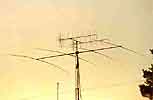 I became a radio amateur and had to start
building my equipment myself: transmitter, receiver, antennas and feeder lines. I built an RTTY decoder (Radio
Teletype, remote printing, just like telex) and had news bulletins printed directly from the short-waves, on a
teletype making as much noise as an express train and had to be lubricated from time to time. There was no Internet
at the time. The motor of the teletype made so much noise on the short-waves that he weaker, more interesting stations
were impossible to hear before I had taken my first, faltering steps as EMI technician, and noise-suppressed it.
I became a radio amateur and had to start
building my equipment myself: transmitter, receiver, antennas and feeder lines. I built an RTTY decoder (Radio
Teletype, remote printing, just like telex) and had news bulletins printed directly from the short-waves, on a
teletype making as much noise as an express train and had to be lubricated from time to time. There was no Internet
at the time. The motor of the teletype made so much noise on the short-waves that he weaker, more interesting stations
were impossible to hear before I had taken my first, faltering steps as EMI technician, and noise-suppressed it.
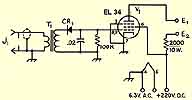 My first RTTY decoder consisted of one, heavily overloaded
electron tube (EL 34 = 6CA7), its anode glowing nicely (although it worked). It was later replaced by a transistorised
variant, with better performance. Being radio amateur, I got the feel for high frequencies, feeder lines, radio
disturbance, EMI, antenna design, fine mechanics and to some extent, radio astronomy.
My first RTTY decoder consisted of one, heavily overloaded
electron tube (EL 34 = 6CA7), its anode glowing nicely (although it worked). It was later replaced by a transistorised
variant, with better performance. Being radio amateur, I got the feel for high frequencies, feeder lines, radio
disturbance, EMI, antenna design, fine mechanics and to some extent, radio astronomy.
 If you want to work seriously with radio, you need a
good radio tower. I studied the theory and practice of truss design and then, together with my father, welded together
the tower shown on the picture. It turned out to be very strong, 15 metres tall without guy wires, and made it
through an autumn storm without a hitch, a storm which blew the roofs of several nearby houses.
If you want to work seriously with radio, you need a
good radio tower. I studied the theory and practice of truss design and then, together with my father, welded together
the tower shown on the picture. It turned out to be very strong, 15 metres tall without guy wires, and made it
through an autumn storm without a hitch, a storm which blew the roofs of several nearby houses.
Holiday work at Mitsubishi |
During my schooldays I worked as service technician at the Mitsubishi repair shop in Södertälje, Sweden, fixing portable tape recorders, TV sets, etc. We also fixed mobile telephones, probably the very first mobile phones available anywhere. These were analog NMT phones working on the 450 MHz band, 15-kilogram monsters housed in a shoulder carrying case, hardly very mobile.
I arrived, without very much experience, and was put fixing portable tape recorders and building base stations for the Swedish mobile phone network. Strangely, I had a lot of tape recorders coming in with no fault whatsoever. So, I sent them back with a notice saying: "No fault found." When the same set came back a few weeks later with the same fault description as before, the management came to me and asked whether I really knew how to troubleshoot. I had to confess I did not, whereupon a senior technician came and showed me how to find hidden faults.
To my horror he took the set and banged it in the table as hard as he could. Then the fault showed up. A good method I have used ever since. So, it may not be all that wrong to put a boot in the side of a TV set, if you want to find out what's wrong with it.
![]() The caretaker lived in a house beside the repair
shop. His TV was connected to the same cable system as the TV repair shop. The caretaker was a sports fanatic and
one weekend it was the official opening of the Olympic Games. We took a chess pattern generator, connected it to
the cable system and put it on the appropriate channel, before we closed up the place Friday evening. The caretaker
was steaming furious Monday morning...
The caretaker lived in a house beside the repair
shop. His TV was connected to the same cable system as the TV repair shop. The caretaker was a sports fanatic and
one weekend it was the official opening of the Olympic Games. We took a chess pattern generator, connected it to
the cable system and put it on the appropriate channel, before we closed up the place Friday evening. The caretaker
was steaming furious Monday morning...
The repair shop was blessed with a practical joke, before I finished. Everyone at the shop was well aquatinted with one special type of tape recorder. We all knew it by heart. I disassembled one set that was in for repairing, took the soldering iron, desoldered two red wires and switched their places. After this, there was no sign of life from the recorder at all. It must have taken them several hours to find that fault.
My First Computer |
Computers for Big Boys |
As companies started to write standardised operating systems, it was no longer profitable to build your own computers. My very first personal computer was a revamped blood analyser from Pharmacia, using the CP/M operating system from Digital Research. At that time I used the old, famous WordStar 0.92 and printed on a daisy wheel printer from Sprint. In those days you ran anything that moved.
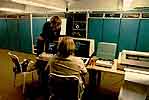 One day I stepped into the world of minicomputers. Stacken, the computer
club of the Royal Institute of Techology (RIT) in Stockholm was a second home to me. We had mainframe computers
we could repair ourselves. The picture shows a PDP-10, bought from Digital Equipment Corporation for 1 krona (10
pence. Today DEC has been blissfully bought by Compaq). It had the designation KA10A and was named Katia. I executed
on it for many years, but it is probably on some museum now.
One day I stepped into the world of minicomputers. Stacken, the computer
club of the Royal Institute of Techology (RIT) in Stockholm was a second home to me. We had mainframe computers
we could repair ourselves. The picture shows a PDP-10, bought from Digital Equipment Corporation for 1 krona (10
pence. Today DEC has been blissfully bought by Compaq). It had the designation KA10A and was named Katia. I executed
on it for many years, but it is probably on some museum now.
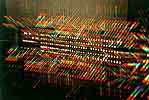 Stacken continued to build ever bigger computer rooms
and got ever bigger computers. the picture shows the front panel of a DEC-1010, a monster of speed with lots of
nice lamps on the front panel. The age of the blinking lamps is though, sadly, gone by.
Stacken continued to build ever bigger computer rooms
and got ever bigger computers. the picture shows the front panel of a DEC-1010, a monster of speed with lots of
nice lamps on the front panel. The age of the blinking lamps is though, sadly, gone by.
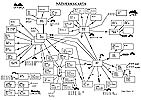 During the 80's I was very
active at the RIT. At the RIT they had an enormous amount of computer of various makes, and between them a very
complicated terminal network, consisting of terminal switches and modem pools. To try to understand everything
I read all the help files, tried to connect to everywhere and asked people who knew. Finally I produced this network
map, which was published in the club magazine of Stacken, the computer club at RIT.
During the 80's I was very
active at the RIT. At the RIT they had an enormous amount of computer of various makes, and between them a very
complicated terminal network, consisting of terminal switches and modem pools. To try to understand everything
I read all the help files, tried to connect to everywhere and asked people who knew. Finally I produced this network
map, which was published in the club magazine of Stacken, the computer club at RIT.
The boxes stand for computers or terminal switches, and the lines between them are communications lines. The texts in the boxes are, from the top: computer name, brand and type, and at the bottom the name of the operating system. All data was not known, and couldn't be flushed out. The phone numbers at the receiver symbols were extra sensitive, because they were gateways into the system. Even more sensitive were the symbols named MODEM, because they were gateways out of the system, from which you could call for free.
Note the enormous capacities of the modem pools: 300 bps and 1200 bps. The UPNOD node has a link to a network which at the time was called ARPANET, what is today the Internet.
The system managers at RIT were not at all pleased with this map. Their goal was to have a few as possible knowing anything about the topology of the network, all the phone numbers, etc. I was strictly instructed not to repeat this in the future.
Nowadays RIT has an Ethernet and no one needs a map to navigate anymore.
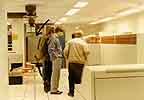 Stacken went on educational trips here and there in
the Nordic countries. Here is a picture I took in the computer room of Turkku University in Finland. Stacken is
eagerly watching the insides of the machine giving computational power to the university, but my sharp eyes found
something much more interesting!
Stacken went on educational trips here and there in
the Nordic countries. Here is a picture I took in the computer room of Turkku University in Finland. Stacken is
eagerly watching the insides of the machine giving computational power to the university, but my sharp eyes found
something much more interesting!
The black arrow points to an older type of cabinets, that turned out to contain a Wegematic 1000, the very first commercial Swedish-built electron tube computer. We quickly threw away all boxes that hid it, rolled it out into the light, opened all doors and got ourselves inside it. A real live electron tube computer isn't something you see every day. We found one person with operating experience, and he could kill the myth that had it that the tubes would break so often, that the machine would be more or less always out of operation. To his recollection, it could work smoothly for about two weeks without stopping.
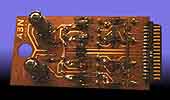 We took one of the electron tube
modules home as souvenir. Please note the text “ABN, Sweden” (Bo Nyman Ltd.) in the top left corner. In those days,
Sweden was one of the world's leading producers of computers, headed by companies like Saab, Facit, Electrolux,
LM Ericsson and ABN-bolagen, most of them doing other things today. The picture probably shows one or two logic
gates. The card is unique in that it is one of the first circuit boards on laminate. But the designers haven't
yet gone all the way; the conductors are on the board, but the components are soldered to standoffs. The backplane,
although, was invented. The cards are all plugged in rows into a wired backplane, see below.
We took one of the electron tube
modules home as souvenir. Please note the text “ABN, Sweden” (Bo Nyman Ltd.) in the top left corner. In those days,
Sweden was one of the world's leading producers of computers, headed by companies like Saab, Facit, Electrolux,
LM Ericsson and ABN-bolagen, most of them doing other things today. The picture probably shows one or two logic
gates. The card is unique in that it is one of the first circuit boards on laminate. But the designers haven't
yet gone all the way; the conductors are on the board, but the components are soldered to standoffs. The backplane,
although, was invented. The cards are all plugged in rows into a wired backplane, see below.
 “Captain! I will try mind-melting
with the machine.” Like a Mr. Spock I tried to feel the inner thoughts and visions of the machine, but it was too
primitive for my advanced brain. No hail frequency worked. Also, note the rows of lovely electron tubes in the
background.
“Captain! I will try mind-melting
with the machine.” Like a Mr. Spock I tried to feel the inner thoughts and visions of the machine, but it was too
primitive for my advanced brain. No hail frequency worked. Also, note the rows of lovely electron tubes in the
background.
Around this time, the mail programme KOM was developed at QZ - Stockholms Datamaskincentral (The Stockholm Computing Centre), the very first e-mail installation in Sweden. QZ was a service bureau providing the RIT and FOA (The Swedish Military Research Institute) with computing power in these days. KOM soon became the most popular discussion medium at the Royal Technical Institute. There were several hundred users, and we filled up the hard disks very fast. KOM is also on a museum now, because we have the Internet.
Ericsson Military Division |
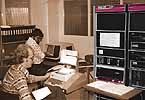 We had a PDP 11/70, a nice 16 bit
minicomputer, and if one was in luck, and had booked a session on beforehand, one might be blessed with using the
CRT terminal for half an hour. But learners like me had problems getting close to the big boy's tools. I had to
sit at the Teletype most of the time. Being used to the hard-to-press, mechanical keys of the Teletype, I always
hit the keys of the CRT terminal too hard, rendering me the nickname “The Sledgehammer”. This picture shows the
inner sanctum of the Military Division at Älvsjö, Sweden, the computer room. I have colorized this originally
black and white picture, and tried to get the colours right on the PDP computer and on the Teletype. The rest is
less important.
We had a PDP 11/70, a nice 16 bit
minicomputer, and if one was in luck, and had booked a session on beforehand, one might be blessed with using the
CRT terminal for half an hour. But learners like me had problems getting close to the big boy's tools. I had to
sit at the Teletype most of the time. Being used to the hard-to-press, mechanical keys of the Teletype, I always
hit the keys of the CRT terminal too hard, rendering me the nickname “The Sledgehammer”. This picture shows the
inner sanctum of the Military Division at Älvsjö, Sweden, the computer room. I have colorized this originally
black and white picture, and tried to get the colours right on the PDP computer and on the Teletype. The rest is
less important.
The same computer room also housed an old control computer for an AXE type telephone switch, built out of discrete components. It was running, idle. I sacrificed the only telephone in the computer room, removed the earpiece, and connected it to one data bit in the CPU, which made it possible to play music.
The melodies were stored on a drum memory, a fantastic storage unit looking like a small nuclear reactor. It could store several megabytes. It was a black cube 0.5 by 0.5 by 0.5 metres, sticking up from a hole in the floor. It hummed and vibrated a little, and had to be filled up with helium once a month. Sometimes the technician having it under his wings, would come in and squeeze it to find out if there was enough pressure inside. The sides should be bulging outward slightly. If too much helium had leaked out, the memory would loose its cooling and the reading heads wouldn't have enough atmosphere to fly on.
Suddenly, one day, there was a dirty hippie with long hair in the computer room, wanting to sell LP's with Indian meditation music. We didn't buy any, so he disappeared again. Later, I started wondering about how he had made it through the guards...
Laser and Fine Mechanics |
 The gas laser (orange red beam, Helium-Neon) had dropped in price
so much an interested amateur could afford to buy one. I got a bargain 2 milliwatt laser and started experimenting
with holograms and various types of deflectors. The picture shows my laser laboratory in the basement, during an
experiment with a rotating deflector.
The gas laser (orange red beam, Helium-Neon) had dropped in price
so much an interested amateur could afford to buy one. I got a bargain 2 milliwatt laser and started experimenting
with holograms and various types of deflectors. The picture shows my laser laboratory in the basement, during an
experiment with a rotating deflector.
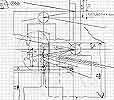 Everything culminated when I decided to build
an X-Y-deflector, to be able to draw pictures on the wall with the laser. A large effort in fine mechanics and
magnetic technology was needed, so I had to sit down at the drawing board. After a lot of persuasion, I got one
technician at ABEM to customise two 2 kHz micro galvanometers, which were originally designed for ultraviolet strip
chart recorders, whereupon I could finish the deflector unit. It worked as calculated.
Everything culminated when I decided to build
an X-Y-deflector, to be able to draw pictures on the wall with the laser. A large effort in fine mechanics and
magnetic technology was needed, so I had to sit down at the drawing board. After a lot of persuasion, I got one
technician at ABEM to customise two 2 kHz micro galvanometers, which were originally designed for ultraviolet strip
chart recorders, whereupon I could finish the deflector unit. It worked as calculated.
My First PC, Computers Become Standardised |
CP/M disappeared as MS-DOS came on the scene, and from now on all machines were factory built. I bought my first PC in 1982, an 8086 PC from Victor, sporting EGA graphics and 20 MB of hard disk. Colour graphics was very unusual at the time, and the price 30,000 kronor (£3000) made it the most expensive computer I have ever bought. I paid the bank loan for 10 years.
In later years PC development hasn't been very exciting, because the machines get faster and faster, while the software becomes slower and slower. My first word processor, WordStar for CP/M used no more than 100 kB on one diskette and could do more or less everything you would expect from a word processor. Corel System's WordPerfect 8 was released early in 1998 and uses 120 MB fully installed, and it too, can be used for typing text, spell checking and printing. Status Quo.
Digital Radio |
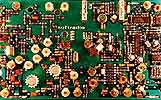 Exciting things happened at the Linköping
Technical Institute (LiTH) in the beginning of the 80's: wireless computer networks. That was something new. The
network was distributed on the 432 MHz amateur radio band, and everyone who wanted to join in could buy a kit.
LiTH had symposia and there was a sister club founded in Stockholm. We built day and night and programmed the client
computers in Forth language, which was new and exciting then. Above all: it was fast and compact and memory-saving.
Exciting things happened at the Linköping
Technical Institute (LiTH) in the beginning of the 80's: wireless computer networks. That was something new. The
network was distributed on the 432 MHz amateur radio band, and everyone who wanted to join in could buy a kit.
LiTH had symposia and there was a sister club founded in Stockholm. We built day and night and programmed the client
computers in Forth language, which was new and exciting then. Above all: it was fast and compact and memory-saving.
We had plans on regional networks in the big cities and backbone networks between the larger cities. At the time, the project was scrapped because of lack of time, but today it is realised commercially, and is called “the GSM network.”
Until now, technology had been mostly play for me, but now the harsh reality of working life waited.
Networks Arrived |
 About 1988 I saw a personal computer
network for the first time. Networks had come down from their mainframe computer pedestal and were being deployed
in small companies. What I saw was NetWare 2, “Jurassic NetWare” being installed. The box was one metre long and
contained the largest number of diskettes I had seen. I was amazed with the intricateness of the installation,
but during the years Novell has fixed things. Later, I have been systems administrator on many NetWare networks.
What made me start writing books about NetWare was the fantastic, astounding amount of configuration possibilities.
This one is from 1993.
About 1988 I saw a personal computer
network for the first time. Networks had come down from their mainframe computer pedestal and were being deployed
in small companies. What I saw was NetWare 2, “Jurassic NetWare” being installed. The box was one metre long and
contained the largest number of diskettes I had seen. I was amazed with the intricateness of the installation,
but during the years Novell has fixed things. Later, I have been systems administrator on many NetWare networks.
What made me start writing books about NetWare was the fantastic, astounding amount of configuration possibilities.
This one is from 1993.
Through the Years |
I have been working with a lot of different technologies. Actually I started as a FORTRAN programmer on the military division of LM Ericsson and used a PDP-11, but soon I changed to servicing phototypesetting machines, the precursors to today's laser typesetters.
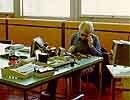 These machines were wonders of fine mechanics, with myriads
of gearwheels and motors, and a little 8080 in one corner. One of the main manufacturers was Bobst S. A., situated
in Lausanne in Switzerland. Out of the machine came beautifully typeset text on photographic paper which had to
be handled in darkness and then developed. These typesetters were mechanical wonders of micrometer precision, but
this high accuracy took a lot of maintenance. The picture shows me, trying to repair a portable computer some time
in the beginning of the 80's, at the Bobst factory in Switzerland, where I was on several courses.
These machines were wonders of fine mechanics, with myriads
of gearwheels and motors, and a little 8080 in one corner. One of the main manufacturers was Bobst S. A., situated
in Lausanne in Switzerland. Out of the machine came beautifully typeset text on photographic paper which had to
be handled in darkness and then developed. These typesetters were mechanical wonders of micrometer precision, but
this high accuracy took a lot of maintenance. The picture shows me, trying to repair a portable computer some time
in the beginning of the 80's, at the Bobst factory in Switzerland, where I was on several courses.
Somewhere around the beginning of the 80's, community radio (Närradio, non-government operated, non-commercial, small, local radio stations in Sweden) became popular with small societies and clubs, as the costs were modest. I became the one and only technician for the House-Owner's Society in Södertälje, Sweden, and recorded, spliced tape, and edited one show per week. In the beginning I wasn't so proliferate in falsifying interviews, but after some six months I became so good in splicing tape I could splice in the middle of spoken words, and make people say things they had never said. Later community radio nearly died out, or at least went into hibernation, as the commercial pop stations took over. I guess Radio Krishna did their part, too.
Audio technology has always interested me, so rather early I of course bought a four track Revox A-77. An outstanding Swiss quality tape recorder, that can take long operating hours and has good brakes. It is easy to calibrate and repair, too.
 Some brands of audiotape released unusual amounts of
magnetic particles (among them Scotch and Agfa) that stuck to the tape heads and impaired the sound quality. I
solved the problem by putting a band of cloth around a pin that would take up the particles before they would deposit
on the heads. The humorous part happened when I was in a haberdasher's shop trying to buy the cloth band.
Some brands of audiotape released unusual amounts of
magnetic particles (among them Scotch and Agfa) that stuck to the tape heads and impaired the sound quality. I
solved the problem by putting a band of cloth around a pin that would take up the particles before they would deposit
on the heads. The humorous part happened when I was in a haberdasher's shop trying to buy the cloth band.
- Do you have quarter inch cloth band? (No one knows about inches in Sweden!)
- Quarter inch??!?
- Well, that is 6.35 millimetres
- What colour would you like?
- It doesn't matter. I'm going to use it for cleaning magnetic tape.
After some deliberation the lady finally understood what I wanted and found a band for me. She managed to keep
a straight face and commented:
- Well, now I know what they'll want it for, the next time someone asks for 6.35-mm cotton band.
Binaural stereo, artificial head stereo, became popular and I built my own binaural stereo microphone from a mannequin head and two condenser microphones. Binaural stereo so mimics the human hearing that you are actually able to hear sounds behind, in front of, below and above yourself in the finished recording, just as you do with your own ears in everyday life. It gives a tremendous sense of presence that ordinary multi-microphone stereo cannot convey, especially if the microphone is placed in the audience.
 The culmination of all this was a Nordic Choir Festival arranged by
the Nordic Society in a school in Södertälje, Sweden in 1980. This school has a fantastic auditorium
four floors high and with terrific acoustics. Having the microphone on the second floor and fifteen choirs with
a total of 500 singers on all floors above and below and the grand Chamber Choir of Södertälje on the
main podium, it made a great recording. It was later immortalised on a vinyl record (Nordisk körfestival i
Södertälje 1980, ES008 ©1980), although I must say my original tapes are better. The recording studio
was careless with frequency compensation.
The culmination of all this was a Nordic Choir Festival arranged by
the Nordic Society in a school in Södertälje, Sweden in 1980. This school has a fantastic auditorium
four floors high and with terrific acoustics. Having the microphone on the second floor and fifteen choirs with
a total of 500 singers on all floors above and below and the grand Chamber Choir of Södertälje on the
main podium, it made a great recording. It was later immortalised on a vinyl record (Nordisk körfestival i
Södertälje 1980, ES008 ©1980), although I must say my original tapes are better. The recording studio
was careless with frequency compensation.
That was my only success in the recording industry. Later, I have made only private recordings in churches around Södertälje.
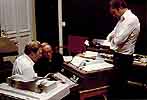 Optical Character Recognition (OCR) was the next stop, having customisation
and installations as main theme. The picture shows an intense evening session, with me and some technicians from
Olivetti dealing with an advanced customer project: to make an Alpha page reader from Compuscan work together with
an Olivetti terminal.
Optical Character Recognition (OCR) was the next stop, having customisation
and installations as main theme. The picture shows an intense evening session, with me and some technicians from
Olivetti dealing with an advanced customer project: to make an Alpha page reader from Compuscan work together with
an Olivetti terminal.
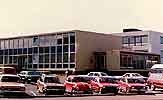 The company where I worked, also had OCR
readers for credit card slips and the like, and we sold one to Postgirostofan (the Postal Giro on Iceland). They
used to have their postal giro slips read at IBM's facility, as they had big, fast machines, but they had grown
tired of IBM's resistance to change and wanted their own equipment. I went to Reykjavik and installed it.
The company where I worked, also had OCR
readers for credit card slips and the like, and we sold one to Postgirostofan (the Postal Giro on Iceland). They
used to have their postal giro slips read at IBM's facility, as they had big, fast machines, but they had grown
tired of IBM's resistance to change and wanted their own equipment. I went to Reykjavik and installed it.
I moved to another company which made bank equipment, where I began doing pure microcomputer design. Among other things, I learnt high speed photography, and how to build interfaces for the old Swedish personal computer, the ABC 80.
 After some time, the company started producing medical equipment,
and I relocated to that department and built switched servo amplifiers, optical sensors and power supplies. Medical
science had found out that lighter forms of back pain, occasional compressions of the spine (occupational injuries
etc.) could be treated by stretching the back, under controlled conditions. We built a microcomputer equipped back-stretcher
and had it exhibited during the medical exhibition Läkarstämman in Älsvjö, Sweden one year.
That's where these pictures come from. Most of the electronics inside is mine.
After some time, the company started producing medical equipment,
and I relocated to that department and built switched servo amplifiers, optical sensors and power supplies. Medical
science had found out that lighter forms of back pain, occasional compressions of the spine (occupational injuries
etc.) could be treated by stretching the back, under controlled conditions. We built a microcomputer equipped back-stretcher
and had it exhibited during the medical exhibition Läkarstämman in Älsvjö, Sweden one year.
That's where these pictures come from. Most of the electronics inside is mine.
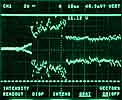 My next field of work was EMI (radio interference) and how to prevent
it. Very interesting for a radio amateur. At this time we began to see digital oscilloscopes in the gigahertz range,
which really eased the designer's work. Suddenly it was possible to see those waveforms, which you could only suspect
before, strange electrical phenomena that you would otherwise find only in textbooks.
My next field of work was EMI (radio interference) and how to prevent
it. Very interesting for a radio amateur. At this time we began to see digital oscilloscopes in the gigahertz range,
which really eased the designer's work. Suddenly it was possible to see those waveforms, which you could only suspect
before, strange electrical phenomena that you would otherwise find only in textbooks.
We have now reached the year 1988, when Desktop Publishing became a reality on personal computers. I changed direction, and began to use computers, instead of building them. There I was, making course material, using the first version of Ventura Publisher. Later, I translated Ventura Publisher into Swedish, and that's how my translating business was started.
Somewhere around the end of 1990 I decided I'd had enough of employment, and became my own employer.
Mingling |
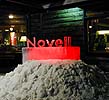 |
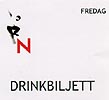 |
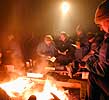 |
 |
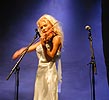 |
 |
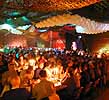 |
 |
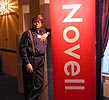 |
 |
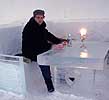 |
 |
 |
 |
Novell Tech Summit 2001 took off in Luleå at Nordkalotten Hotel. Novell explained their strategy with eDirectory and NetWare 6, but what stayed longest in my mind was the festivities. The first night we had the doubtful pleasure of sculpturing snow at minus 18 degrees C, and later we were fed with reindeer shavings in a smoky Saami teepee. My eyes were running, the reindeer tasted nothing, but the picture turned out nice. Aimo Räisänen, the architect who built the famous Ice Hotel at Jukkasjärvi, Sweden, was there, constructing an ice bar. I tried it out. Cold. No need for ice in the drink. One night the whole gang filled up an entire hangar at Kallax Airport and got hot, mystic and suggestive entertainment by the very attractive Finnish Linda Lampenius, minimally dressed.
 Being an eager promoter of Novell, Inc., and a relentless
propagandist for the supremacy of NetWare networks, I 1997 went to Novell's big European developer's meeting Brainshare
in Nice on the French Riviera. It was interesting, not only for the excellent lectures, but also because I got
the opportunity to meet colleagues from exotic countries. A Russian woman told me about the problems they fought,
among the 286'es and the crashed budgets of the former Soviet Union. During the years I have translated several
courses for Novell, plus the accompanying software for knowledge testing, on top of the tree books
I have written on the subject.
Being an eager promoter of Novell, Inc., and a relentless
propagandist for the supremacy of NetWare networks, I 1997 went to Novell's big European developer's meeting Brainshare
in Nice on the French Riviera. It was interesting, not only for the excellent lectures, but also because I got
the opportunity to meet colleagues from exotic countries. A Russian woman told me about the problems they fought,
among the 286'es and the crashed budgets of the former Soviet Union. During the years I have translated several
courses for Novell, plus the accompanying software for knowledge testing, on top of the tree books
I have written on the subject.
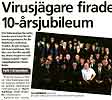 I have mostly nice customers, who let me in on their parties.
Here is a picture from the mingling on QA Information Systems Italian all-nighter in an old tram museum in Stockholm.
A scandal reporter from Computer Sweden magazine was there, and yours truly ended up in the report. QA is the Swedish
representative of Dr. Solomon's Anti-Virus Toolkit. I have translated many texts for them, and translated and typeset
their complete series of handbooks for all machine platforms. Read more.
I have mostly nice customers, who let me in on their parties.
Here is a picture from the mingling on QA Information Systems Italian all-nighter in an old tram museum in Stockholm.
A scandal reporter from Computer Sweden magazine was there, and yours truly ended up in the report. QA is the Swedish
representative of Dr. Solomon's Anti-Virus Toolkit. I have translated many texts for them, and translated and typeset
their complete series of handbooks for all machine platforms. Read more.
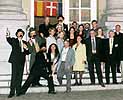 The advertisng bureau C.G.P.
(Communications for Genial Products S.A.) in Brussels is one of those who are nice to us journalists. Here I am
at the stairs of a party castle in Brussels wherein the CGP yearly party 2000 took place. The lady in yellow is
Chalotte Gutman, CEO of CPG, and your's truly is fourth from the right at the back. From the left you see the fun-makers
of this party: detective Thomson from the Securité, professor Calculus, captain Haddock, detective Thompson,
and in front of him, madame Bianca Castafiore, all of them characters out of the famous cartoon Tintin by Hergé.
Hergé was Belgian, thus the choice of characters. Tintin himself, was out with the dog and not in the picture.
I have written several articles of products advertised by CGP, and also contributed to CGP's newsletter.
The advertisng bureau C.G.P.
(Communications for Genial Products S.A.) in Brussels is one of those who are nice to us journalists. Here I am
at the stairs of a party castle in Brussels wherein the CGP yearly party 2000 took place. The lady in yellow is
Chalotte Gutman, CEO of CPG, and your's truly is fourth from the right at the back. From the left you see the fun-makers
of this party: detective Thomson from the Securité, professor Calculus, captain Haddock, detective Thompson,
and in front of him, madame Bianca Castafiore, all of them characters out of the famous cartoon Tintin by Hergé.
Hergé was Belgian, thus the choice of characters. Tintin himself, was out with the dog and not in the picture.
I have written several articles of products advertised by CGP, and also contributed to CGP's newsletter.